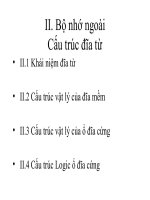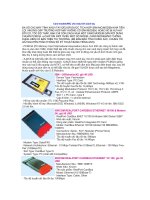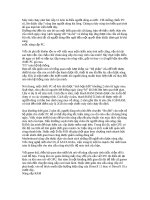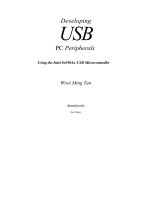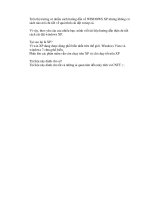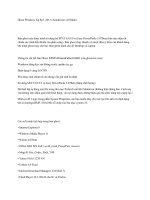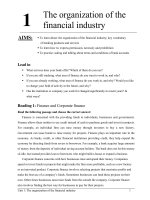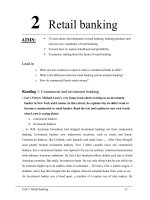usb USB Thư Viện Tài Liệu Tổng Hợp Com 6 USB PC USB
Bạn đang xem bản rút gọn của tài liệu. Xem và tải ngay bản đầy đủ của tài liệu tại đây (1.03 MB, 189 trang )
Developing
USB
PC Peripherals
Using the Intel 8x930Ax USB Microcontroller
Wooi Ming Tan
Annabooks
San Diego
Developing USB PC Peripherals
by
Wooi Ming Tan
Published by:
Annabooks
11838 Bernardo Plaza Court
San Diego, CA 92128-2414
USA
619-673-0870 800-462-1042 Fax 619-673-1432
,
Copyright © Wooi Ming Tan 1997
All rights reserved. No part of the contents of this book may be
reproduced or transmitted in any form or by any means without the
prior written consent of the publisher, except for the inclusion of brief
quotations in a review.
Printed in the United States of America
ISBN 0-929392-38-8 First Printing July
1997
ii
Information provided in this publication is derived from various sources,
standards, and analyses. Any errors or omissions shall not imply any
liability for direct or indirect consequences arising from the use of this
information. The publisher, author, and reviewers make no warranty for
the correctness or for the use of this information, and assume no liability
for direct or indirect damages of any kind arising from technical
interpretation or technical explanations in this book, for typographical or
printing errors, or for any subsequent changes.
The publisher and author reserve the right to make changes in this
publication without notice and without incurring any liability.
Intel, Microsoft, and Win32 are registered trademarks. Windows,
Windows 95, and Windows NT are trademarks of Microsoft Corporation.
All other trademarks, copyrights, and registered names mentioned in this
book are the property of their respective owners. Annabooks has
attempted to properly capitalize and punctuate trademarks, but cannot
guarantee that it has done so properly in every case.
Disclaimer
The information or comments in this book reflects the author's own
opinions; it does not represent the view of Intel Corporation, USB IF,
Microsoft, or any other vendors.
The design example depicted in this book is not production-worthy,
designers are required to modify the design to adhere to FCC and USB
device class specifications. Readers assume all risks if they wish to
follow the example; the author and publisher are not responsible or liable
for any injuries or mishaps caused directly or indirectly by following the
design example.
iii
About the Author
Wool Ming is a Senior Technical Marketing Engineer for Intel USB
Microcontrollers. He focuses on USB, microcontroller architecture,
firmware development, and the utilization of microcontrollers in various
USB applications. He has been involved in the USB world since the early
days of USB development. He provides technical consultations to
various major OEMs and has helped them to develop and demonstrate
their USB products at several international tradeshows.
Wooi Ming has a Master of Engineering Degree in Electrical and
Electronics Engineering from the National University of Singapore and a
Bachelor Degree in Engineering from the University of Canterbury, New
Zealand. His Master's research was on the behavior of the third
generation digital cordless protocols in fading channels. He has
programmed in C, C++, and various microcontroller assembly
languages, using the IBM PC/DOS, Windows operating system,
VAX/VMS, and UNIX environments. He has experience with data
networks and VAX/VMS systems planning and management, and in the
manufacturing of wireless communications systems.
IV
Dedication
This book is dedicated to
my parents,
my wife Pat, and
my sisters Nee and Ling.
V
Acknowledgements
The author would like to thank
all the members of the USB team
from CEG (Chandler and Penang), 1AL and
the USE IF for
their support.
VII
Contents
1. WHAT WILL THIS BOOK DO FOR YOU?...........................................1
1.1
1.2
1.3
1.4
WHAT is USB, ANYWAY ? ........................................................... 2
OUTLINE OF THE BOOK ................................................................. 3
REFERENCES....................................................................... 4
FEEDBACK TO THE AUTHOR...................................................5
2. STEP1: UNDERSTAND THE USB SPECIFICATION ....................... 7
2.1
2.2
SUMMARY OF USB PROTOCOL ...................................................... 7
USB OBJECTIVES ................................................................ 7
USB Bus TOPOLOGY........................................................................8
USB DATA FLOW MODEL............................................................. 9
2.5 USB PIPE CONCEPT (DEVICE ADDRESS AND ENDPOINT) .......... 10
2.6
USB TRANSFER TYPES................................................................ 11
2.7 USB MECHANICAL AND ELECTRICAL .................................... 13
2.7.1
POWER SUPPLY FROM USB WIRES ............................. 15
2.8 USB PACKET FORMATS ..................................................... 15
2.8.1
TOKEN PACKETS ................................................................ 15
2.8.2
START OF FRAME PACKETS ............................................ 17
2.8.3
DATA PACKETS .........................................................17
2.8.4
HANDSHAKE PACKETS ................................................. 17
2.8.5
SPECIAL PACKETS ........................................................ 18
2.9
USB PROTOCOL BY TRANSFER TYPES ........................................ 18
2.9.1
CONTROL TRANSFERS .................................................18
2.9.2
ISOCHRONOUS TRANSFER ............................................20
2.9.3
BULK TRANSFER ........................................................20
2.9.4
INTERRUPT TRANSFER .................................................21
2.10 USB FUNCTIONS ....................................................................... 21
2.10.1 USB ENUMERATION STEPS ...........................................21
2.10.2 A SNAP-SHOT OF A TYPICAL USB Bus ENUMERATION.........23
2.10.3 USB RESET, SUSPEND, RESUME & REMOTE WAKEUP ..........27
2.11 USB HOST ........................................................................................28
2.3
2.4
ix
3. STEP 2: SET UP A DEVELOPMENT ENVIRONMENT .....................31
3.1
3.2
3.3
DEVELOPMENT ENVIRONMENT (DEVICE SIDE) ........................31
DEVELOPMENT ENVIRONMENT (HOST SIDE)...........................34
CONTACT NUMBERS ...........................................................35
4. STEP 3: DEVELOPING THE DEVICE HARDWARE .........................37
4.1 OVERVIEW OF THE 8x930Ax USB MICROCONTROLLER..............37
4.1.1
MCS 251 CORE .......................................................... 37
4.1.2
MEMORY ORGANIZATION ........................................... 38
4.1.3
EXTERNAL MEMORY INTERFACE ..................................... 40
4.1.4
INTERRUPT SYSTEM .................................................... 41
4.1.5
8x930Ax ON-CHIP PERIPHERALS ................................... 43
4.1.6
8x930Ax USB MODULE ........................................................ 44
4.1.7
SFRs ASSOCIATED WITH THE USB MODULE....................... 46
4.2 INTERFACE WITH THE 8x930Ax ............................................ 48
5. STEP 4: DEVELOP THE DEVICE FIRMWARE........................................... 49
5.1 OVERVIEW OF FIRMWARE RESOURCES ....................................49
5.1.1
USB FIRMWARE OVERHEAD .......................................... 49
5.1.2
APPLICATION-SPECIFIC FIRMWARE ................................ 49
5.2 FIRMWARE RELATIONSHIP WITH DEVICE CLASS DRIVER........... 50
5.3
THE 8x930Ax OPERATING MODEL ..................................... 50
5.3.1
INITIALIZATION ........................................................ 51
5.3.2
UN-ENUMERATED STAGE.............................................. 52
5.4
USB ENUMERATION CODE ................................................. 56
6. STEP 5: DEVELOP THE USB DRIVER............................................... 59
6.1
DEVICE CLASS SPECIFICATION AND DRIVER ...........................
6.2
OVERVIEW OF WDM ................................................................ 60
59
6.4
WINDOWS NT
6.3 WINDOWS NT SYSTEM OVERVIEW ....................................... 62
6.3.1
WINDOWS NT STRUCTURE ..................................... 64
I/O SYSTEM OVERVIEW ..................................... 66
6.4.1
6.5
6.6
NT OBJECT MODEL ............................................................ 67
WDM DEVICE DRIVER EXAMPLE ......................................... 68
LOADING THE WDM DRIVERS ............................................ 72
X
7. STEP 6: DEVELOPING HOST APPLICATION SOFTWARE............ 79
7.1
7.2
7.3
7.4
MICROSOFT DEVELOPER STUDIO .........................................79
DEVELOP THE APPLICATION SOFTWARE USING APPWIZARD ......80
LINKING APPLICATION SOFTWARE TO THE WDM DRIVER ..............84
COMMUNICATING TO THE WDM DRIVER...............................85
8. USB APPLICATION SOFTWARE. WDM DRIVER AND
FIRMWARE EXAMPLES...................................................... 89
8.1
8.2
8.3
CONTENT DESCRIPTION OF THE ENCLOSED DISKETTE ...............90
SETTING UP THE DEMONSTRATION .......................................91
DELETING DRIVER & ID INFORMATION FROM THE HOST ..........95
9. CONCLUSION ......................................................................................... 97
10. GLOSSARY ......................................................................................... 99
11. APPENDICES ....................................................................................... 107
11.1 FIRMWARE CODE EXAMPLE FOR INTEL
8x930Ax USB MICROCONTROLLER ....................................107
11.2 A WDM DRIVER CODE EXAMPLE ......................................129
11.3 AN APPLICATION SOFTWARE CODE EXAMPLE ........................ 161
XI
Table of Figures
FIGURE 1-1. CHAPTER LAYOUT .......................................................4
FIGURE 2-1. USB BUS TOPOLOGY .......................................................9
FIGURE 2-2. LOGICAL CONNECTIONS FROM HOST TO USB DEVICES .......... 10
FIGURE 2-3. CONCEPT OF THE USB PIPES AND ENDPOINTS.................. 10
FIGURE 2-4. USB CONNECTORS (SERIES A) ...................................... 13
FIGURE 2-5. USAGE OF SERIES A AND SERIES B CONNECTORS .................. 13
FIGURE 2-6. CROSS SECTION OF A FULL SPEED USB CABLE .................. 14
FIGURE 2-7. CONNECTION OF EXTERNAL RESISTORS
IN A FULL SPEED DEVICE ........................................... 14
FIGURE 2-8. A USB TOKEN PACKET ................................................. 15
FIGURE 2-9. FID PACKET FORMAT ................................................... 16
FIGURE 2-10. A USB SOF PACKET .................................................. 17
FIGURE 2-11. A USB DATA PACKET ................................................. 17
FIGURE 2-12. A USB HANDSHAKE PACKET ...................................... 17
FIGURE 2-13. AN EXAMPLE OF CONTROL TRANSFER ........................... 19
FIGURE 2-14. USB ENUMERATION STATE DIAGRAM ............................ 21
FIGURE 2-15. INTER-LAYER COMMUNICATION MODEL ........................ 29
FIGURE 3-1. TASKS TO DESIGN A USB DEVICE................................... 32
FIGURE 3-2. DEVELOPMENT ENVIRONMENT (DEVICE SIDE) ................. 32
FIGURE 3-3. DEVELOPMENT ENVIRONMENT (HOST USB DRIVER) ......... 34
FIGURE 4-1. 8x930Ax PRODUCT OPTIONS ....................................... 37
FIGURE 4-2. 8x930Ax ADDRESSING SPACE WHEN CONFIGURED
TO 256 KBYTES OF ADDRESSING .................................... 39
FIGURE 4-3. PAGE MODE FOR EXTERNAL MEMORY ACCESS .................. 40
FIGURE 4-4. THE USB MODULE OF THE 8x930Ax.............................. 44
FIGURE 4-5. INTERFACES OF THE 8x930Ax ...................................... 48
FIGURE 5-1. USB DEVICE PROGRAM FLOW ....................................... 51
FIGURE 5-2. OPERATION OF TRANSMIT ROUTINES ................................ 53
FIGURE 5-3. OPERATION OF RECEIVE ROUTINES ................................ 54
FIGURE 5-4. OPERATION OF SOF ROUTINE ...................................... 55
FIGURE 5-5. FLOW DIAGRAM OF THE ENCLOSED USB_ENUM.ASM ..... 56
FIGURE 5-6. FLOW DIAGRAM OF THE USB_ENUM.ASM .................. 57
FIGURE 6-1. RELATIONSHIP OF THE USB HOST AND THE USB DEVICE ... 60
FIGURE 6-2. WDM SOFTWARE STACK ............................................. 61
FIGURE 6-3. A CLIENT/SERVER OPERATING SYSTEM........................... 63
FIGURE 6-4. WINDOWS NT BLOCK DIAGRAM ................................... 65
FIGURE 6-5. WINDOWS NT I/O SYSTEM.......................................... 67
FIGURE 6-6. AN I/O REQUEST EXAMPLE ......................................... 72
FIGURE 7-1. STARTING A NEW PROJECT WORKSPACE.......................... 80
FIGURE 7-2. USING APPWIZARD ................................................... 81
XIII
FIGURE 7-3. STEP 1 OF THE OF THE APPWIZARD .................................. 81
FIGURE 7-4. A SKELETON PROJECT CREATED BY APPWIZARD .............. 82
FIGURE 7-5. MENU ITEM PROPERTIES OF THE "ABOUT TEST"................... 83
FIGURE 7-6. ID_APP_ABOUT IN THE
BEGIN_MESSAGE_MAP ROUTINE ................ 84
FIGURE 7-7. ONAPPABOUT() ROUTINE ............................................. 84
FIGURE 8-1. LAB SETUP TO USE THE USB CODE EXAMPLES ...................... 89
FIGURE 8-2. A "UNKNOWN DEVICE" SCREEN ON THE HOST PC ............ 92
FIGURE 8-3. LOADING PROCESS OF WDM DRIVER
FOR THE NEWLY ATTACHED DEVICE............................. 93
FIGURE 8-4. TEST_APP.EXE APPLICATION SOFTWARE USER INTERFACE ... 93
FIGURE 8- 5. ACTIVATE THE MENU ITEM TO GENERATE
AUSB TRANSACTION ............................................... 94
FIGURE 8- 6. USB TRANSACTIONS AS CAPTURED
BY A CATC BUS ANALYZER...................................... 94
FIGURE 8-7. LOCATING THE PRODUCT INFORMATION IN THE REGISTRY .. 95
xiv
Foreword
Universal Serial Bus (USB) is one of the most important developments in
PC peripheral interconnect technology since the introduction of serial
and parallel ports in the early 1980's. It is fast becoming the port of
choice for many new digital video conferencing cameras, scanners,
monitors, PC telephony equipment, and Human Interface Devices such
as keyboards, games, and pointing devices. The benefits of USB, such as
ease of use, true plug and play, high performance, and reduced overall
system cost, are just a few of the reasons this technology has gone from
specification to product deployment in less than two years.
Wooi Ming Tan has provided in this book a very timely introduction
to the concepts of USB as well as a very practical guide on how to design
USB peripheral products. With his early involvement in USB at Intel
Corporation, he has faced many of the design issues that engineers will
likely encounter as they begin product development. The book also
provides a useful overview for those just interested in gaining a more
thorough understanding of USB, such as project management, sales, and
marketing personnel involved in serial bus interconnect.
I am very pleased to see this book providing an easy step-by-step
methodology to allow more USB products to quickly come to market
while following a thorough design practice. Wooi Ming Tan's experience
in USB and microcontroller technology certainly comes across in the
book, allowing the reader to save many hours in USB peripheral design.
Stephen Whalley
Chairperson, USB Implementers Forum
XV
1. What Will This Book Do For You?
"Everybody talks about USB, what is it?"
"Can USB benefit my current products?"
"How hard is it to understand USB?"
"How do we go about designing a USB device?" "Where do I start?"
"There are USB hosts, WDM, USB devices, firmware..., where can I get
all the information?" "I need all of this info in one place!"
"Do I need to develop a device driver for my USB device?"
"Will USB get rid of the PC add-in cards?"
"Wow, if I don't need
the add-in cards for my devices, I can reduce the cost by..."
"Can our current RS-232 device use the benefits of USB?"
"How many engineers or computer scientists do I need to design a USB
device?"
"Where can I find a summary of USB protocol?"
250 pages!"
"The spec is over
"Do I need to attend a class to understand USB ? Device Driver Class?"
"Where do I get more info to develop my USB device?"
This book is written with the aim of answering these questions. It is
intended for USB device project managers, USB design engineers, USB
device marketing staff, or USB sales personnel. It is also meant for those
who are interested in USB; who would like to know more about USB and
how to start developing USB devices. A step by step method is used to
guide you in developing USB devices. The book is meant not only for
beginners, but also for those who have some USB experience. They can
1
What is USB, Anyway ?
use this book to develop a more complete view of the steps required to
design a USB device.
The book shows you the steps required to start developing USB
devices; it discusses USB protocol, a USB microcontroller and its
firmware operating model, USB device drivers based on the Windows
Driver Model (WDM), Windows Applications, and the development
tools needed to develop USB devices. The book also includes a design
example and its source codes. By studying the code examples provided
on the enclosed diskette, designers can get a good insight into the
requirements of developing the firmware codes, drivers, and application
software. This book and the code examples can easily cut weeks of
development time off your USB device design effort.
1.1 What is USB, Anyway ?
Lots of PC users have had bad experiences installing PC peripherals. We
connect external devices to our PC, but before long, we run out of serial
or parallel ports. Once we start to open the PC box to install expansion
cards, add-in cards, etc., things become even more complicated. We face
a complex and astonishing number of dip switches, jumper cables,
software drivers, IRQ settings, and I/O addresses that must be
configured. We are typically required to go through hundreds of pages
of the installation guides just to install our peripherals successfully.
Sometimes, we even need to call the dreaded "Please hold for the next
available representative" technical hot-lines to get things straightened
out.
The era has finally arrived to forget about all the troubles of installing
new PC devices. This is the era of the Universal Serial Bus (USB). The
USB Specification Rev 1.0[1] was finally released to the world on January
15, 1996; royalty free! The spec is a joint collaboration among seven
leading computer, telecommunications, and software companies:
Compaq, Digital Equipment Corporation, IBM PC Company, Intel,
Microsoft, NEC, and Northern Telecom. Many other companies now see
the potential of USB and have jumped on the bandwagon. To date, the
USB-Implementers Forum[2] has over 300 members. PCs with USB
connectors have started appearing in the market and many USB devices
are currently available with more becoming available soon.
USB brings true Plug and Play convenience to PC users for the first
time in PC history. It makes the process of adding a new peripheral as
2
What Will This Book Do For You?
easy as plugging a phone line into the connector on the wall. We do not
have to worry about the number of available ports, the dip switches, the
jumpers, the IRQs, the installation guides, etc. All that is required to
install a new peripheral is to connect the peripheral to a USB socket. The
PC will recognize the new device and activate the appropriate
applications. We can even install the device when the PC is up and
running; USB is truly Plug and Play! Not only that, USB also creates an
opportunity for exciting new applications, like digital cameras,
multimedia devices, telephony devices, and multi-user games. It opens
up huge opportunities for companies to profit from these exciting PC
devices.
This is what this book is all about; guiding you, step by step, in
developing a USB device. The book is meant for anyone that wants to
know more about USB and USB devices. It also includes code examples
on the enclosed diskette to give readers a thorough understanding of the
steps involved in developing a USB device. The disk includes sample
code for USB firmware, the WDM driver and application software as a
reference for anyone who wishes to develop USB devices. Use of this
code is described in Chapter 8.
1.2 Outline of the Book
There are nine chapters in this book. Chapters 2 through 7 consist of
various steps required to develop a USB device, as shown in Figure 1.1.
Each of the chapters contain only relevant material to get you started in
executing the steps. References are quoted appropriately throughout the
book to direct you to extra or more detailed information.
With this organization of the book, readers who know USB, for
instance, can skip Chapter 2 and go straight to Chapter 3 for the
"Development Environment". I'll show you how some of the
development tasks can be done in parallel thereby reducing the elapsed
time to develop a USB device and shortening the time to market for the
device. The steps will be discussed in more detail in later chapters.
3
References
Introduction to this book
Firmware, WDM Driver, and Application Software
Next Step
Figure 1-1. Chapter Layout
1.3 References
These references will appear several times throughout the book. They
will be designated by their number in subscript next to the referral For
example, you'll see something like this [1].
[1] Compaq, Digital Equipment Corporation, IBM PC Company, Intel,
Microsoft, NEC, and Northern Telecom, ''USB Specification 1.0",
revision 1.0, Jan 19,1996.
4
What Will This Book Do For You?
[2] To join the USB Implementers Forum, contact:
USB IMPLEMENTERS FORUM
JF2-51, 2111 NE 25th Avenue
Hillsboro, OR 97124 For more
information, see
[3] "8x930Ax, 8x930Hx USB Microcontroller User's Manual", order no:
272949-001, September 1996. It can be ordered from: Intel
Corporation Literature Sales P.O. Box 7641
Mt. Prospect, IL 60056-7641 Or call
1-800-879-4683 or
/>[4] "8x93QAx USB Microcontroller Datasheet", order no: 272917-003,
February 1997, and the "8x930Ax Specification Update", order no:
272940 available at />[5] Helen Custer, "Inside Windows NT", Microsoft Press, a Division of
Microsoft Corporation, 1993.
[6) Dave Hamilton and Mickey Williams, "Programming Windows NT 4",
Sams Publishing, 1996.
[7] Ori Gurewich and Nathan Gurewich, "Teach Yourself Visual C++ 4 in 21
Days", Sams Publishing, 1996.
1.4 Feedback to the Author
It was my top priority to ensure that all the information provided is as
correct as possible, and as simple as possible to understanding.
However, if you find any errors or omissions that are critical to this book,
please send your feedback to the author. Thank you — and get into the
BUS.
E-Mail address:
5
Step 1: Understand the USB Specification
2. Step 1: Understand the USB
Specification
The first step to design a USB device is to understand the USB
Specification. The USB Specification 1.0 has 267 pages; however, the
good news is that we do not have to go through all the pages before
starting to design a USB device. This chapter gives sufficient knowledge
of the USB Specification, made simple to comprehend, for us to start
designing a USB device. For more details, refer to the USB Specification
1.0[1]
2.1 Summary of USB Protocol
USB is a 12 Mbps serial channel that is shared by a wide variety of PC
peripherals, up to 127 peripherals total can be mounted in a single PC. It
has four wires: two wires for supplying the power, and two wires for
data transfer. It is a token-based bus protocol, where the USB host is the
master of the bus. The host broadcasts tokens on the bus and a device
that detects a match in its address, as described in the token, responds to
the host. The 12 Mbps bandwidth of the bus is framed into 1 ms slots
and shared by all the devices in the bus in a time division multiplexed
(TDM) manner. The host has knowledge of all the bus access
requirements of its devices, and schedules all the bus activities.
2.2 USB Objectives
USB was developed to achieve three main goals:
• Ease of use
It achieves this goal by providing a hot, out-of-box, Plug and Play
environment. Users do not have to open the PC case, configure
interrupts, set dip switches, and so forth, just to install a new PC
peripheral. All you have to do is attach the USB device to a USB
connector. The USB PC will recognize the newly attached device
instantly and exchange information with the device about its
7
USB Bus Topology
manufacturer, its type, its version number, and so forth. If a USB device
is detached from the PC, the PC will recognize this and notify the
application software of the device. The application may then notify users
that the device has been removed.
• PC-phone connection
USB provides the ability to support real time data (e.g., voice, audio,
and compressed video), and asynchronous messaging. For example,
before USB, it was extremely difficult to provide a voice path together
with control data into or out of a PC using serial or parallel ports. With
USB, the voice and control data are divided into different pipes that go
into or out of a PC. This is achieved using the "endpoint" notation (more
of this in later sections). Moreover, USB can bring multiple voice paths
into and out of the PC, which cannot be easily done by serial or parallel
ports.
• Port expansion
USB provides a low-cost PC port extension and allows up to 127
device attachments for a single PC host. The low-cost objective is one of
the reasons that the USB rate is at 12 Mbps, as higher rates usually mean
more expensive shielding, chip sets, components, etc. There are, in fact,
two categories of USB devices that can be connected to the same USB
host; one consists of full speed devices at 12 Mbps and the other type
consists of low speed devices at 1.5 Mbps. Examples of low speed
devices are mice and keyboards, which do not require the full 12 Mbps
speed and are very cost sensitive.
With the 12 Mbps (and 1.5 Mbps low speed) bus in mind, USB is not
targeted for very high speed applications like disk drives or full motion
video applications. It is targeted for low and medium speed
applications, like keyboard, mice, modems, CTI, low-speed scanners,
low-speed printers, and low-speed cameras. As a rule of thumb, a device
that requires more than 4 Mbps of bandwidth constantly is not suitable
as a USB device.
2.3 USB Bus Topology
The USB Specification defines the interconnections and communications
between two main elements of a USB system: USB host PC and USB
devices. Its physical interconnection topology is a tiered star, as shown
in Figure 2-1.
8
Step 1: Understand the USB Specification
HOST/
ROOT HUB
PHONE
USB
FUNCTIONS
MONITOR
HUB
MICE
HUB
KEYBOARD
USB
FUNCTIONS
USB
FUNCTIONS
Figure 2-1. USB bus topology
There is only ONE host in a USB system. The USB Host is a PC with a
USB host controller and it may be implemented in a combination of
hardware, firmware, or software. In this book, we focus on the USB
devices. The details of the USB host can be found in Chapter 10 of the
USB Specification [1]. The host is the master of the USB system. It
controls and schedules all the activities in its system. A root hub is
integrated within the host to provide one or more attachment points.
There are two types of USB devices: USB Hub and USB functions. The
USB hubs provide extra attachment points for the system. We can think
of them as the socket extensions used to connect additional electrical
appliances. The USB functions provide capabilities to the system, e.g.,
keyboard, joystick, etc. The USB functions are the focus of this book and
the terms "function" and "device" are used interchangeably in this book.
2.4 USB Data Flow Model
USB provides a protocol for communications between the devices and
the host. Although the bus topology of a USB system is a tiered star
(Figure 2-1), the connection of the USB devices to the USB host can be
thought of as one-to-one, as shown in Figure 2-2. This is referred to as
9
USB Pipe Concept (Device Address and Endpoint)
the logical connections of the USB system. The data flow model is based
Host
on these logical connections.
Figure 2-2. Logical connections from host to USB devices
2.5 USB Pipe Concept (Device Address and
Endpoint)
USB communication can be viewed using a pipe concept, as shown in
Figure 2-3.
HOST PC
BIG USB PIPE
(12 Mbps)
small pipe to each
USB device (up to
127 devices using
device address)
tiny pipes
(endpoints)
Figure 2-3. Concept of the USB pipes and endpoints
It consists of a big pipe (12 Mbps) and up to 127 small pipes. Each of
the small pipes connects to a USB device. There are 7 address bits in the
USB token (more details in section USB Packet Formats) which can
10
Step 1: Understand the USB Specification
address up to 128 devices. However, address 000 OOOOB, called the USB
default address, is used for all devices when they are first attached. Thus
USB can support up to 127 devices. Each of the small pipes connected to
a USB device can be further divided into smaller pipes, which we refer to
as tiny pipes, as shown in Figure 2-3.
There can be up to 16 pairs of these tiny pipes from a single small
pipe. This is because there are 4 "endpoint" bits in a USB token and the
token can be identified as IN or OUT tokens. After a device receives an
IN token, it will transmit data to the host, and if it receives an OUT
token, it will anticipate data from the host. The "endpoints" are
associated with tiny pipes here to illustrate the USB pipes concept clearly
to readers. These endpoints (or tiny pipes) are the most important
concept designers need to understand. In a multimedia USB device, for
example, one of the endpoints may carry data, one may carry voice and
the other may carry control information. All these packets are required
to be treated differently, for instance, data for file transfers (e.g. files to be
sent to printers) requires high accuracy in delivery, often less than 1 x 10-10 in
bit error rate. On the other hand, raw voice data can tolerate up to 1 x
10-3 in bit error rate but cannot tolerate excessive delay (typically delay of
> 20 ms is considered bad). However, USB is designed to carry all of this
different information and it can all be communicated with through the
USB connection, with the endpoint concept used to separate according to
data type, sources, etc.
2.6 USB Transfer Types
There are four USB transfer types; i.e. (1) control, (2) isochronous, (3)
interrupt, and (4) bulk.
(1) Control Transfer
Control transfers are bi-directional and intended to support
configuration, command or status communications between the host and
functions. A control transfer consists of 2 or 3 stages: a setup stage, data
stage (may or may not exist) and status stage. In the setup stage, the host
sends a request to the function. In the data stage, data transfer occurs in
the direction as indicated in the setup stage, and in the status stage, the
function returns a handshake to the host.
Each USB device is required to implement the endpoint pair 0 as
control transfer endpoints. It is used to exchange information (see
enumeration section under USB Functions) when the device is first
11
USB Transfer Types
attached to the host. USB ensures that the control transfer is delivered
without error. This is done using CRC error checking (see section USB
Packet Formats) and re-transmission if the error cannot be recovered.
(2) Isochronous Transfer
Isochronous transfer can be uni-directional or bi-directional. It is
intended to be used to transfer information that requires a constant rate
and can tolerate errors. A good application example of this transfer type
is 64 kbps Pulse Code Modulation (PCM) voice data. The voice data
requires a constant rate and can tolerate errors (typically up to a bit error
rate of lxl0 - 3 ).
Isochronous transfer has the following characteristics:
— guaranteed access to USB with bounded latency, and
— no retrying in case of a delivery failure due to error.
The maximum packet size for isochronous transfer is 1023 bytes per
USB frame of 1 ms. This implies that the maximum transfer achievable
using isochronous transfer is 8,184 Mbps.
(3) Interrupt
Interrupt transfer is uni-directional and only inputs to the host. It is
used to support data transfers that are small in size and happen
infrequently. The interrupt transfer of USB is of a polling type; that is,
the host asks if the interrupt endpoints have any data to send according
to the frequency requested by the endpoints. For full speed devices, the
endpoint can specify the polling period of 1 ms to 255 ms. For low speed
devices, the polling period is from 10 ms to 255 ms. Thus, the fastest
polling frequency is 1 kHz for full speed devices. In case of delivery
failure due to errors, a retry of transfer will be carried out in the next
polling period. A good example of a device using interrupt transfer is a
keyboard, where it sends a small amount of data to the host when a key
is pressed.
(4) Bulk Transfer
The bulk transfer can be uni- or bi-directional. It is used to support
endpoints that need to communicate large amounts of data accurately
but where the time of delivery is not critical. The bulk transfer is
designed to claim unused bandwidth of the USB, and therefore the
provision of USB access time to bulk transfers is on a bandwidth
available basis. In case of delivery failure due to errors, the transfer is
retried. A typical usage is a scanner, where a large amount of data needs
to be delivered accurately, but not immediately.
12

